Here's something I just read in my latest issue of Cook's Illustrated: "While the incredible juiciness of a ripe peach is the source of the fruit's deliciousness, it's also the reason fresh peaches can be tricky to use in pies. Flavor is the hallmark of any fruit pie, but ripe peaches give off so much juice that they require excessive flavor-dampening binders to create a filling that doesn't turn to soup.
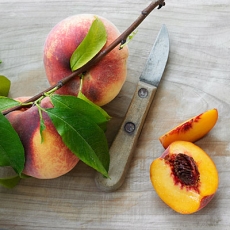 "And depending on the variety, fresh peaches also differ dramatically in water content. So figuring out how much thickener to add is a guessing game. Finally, ripe peaches are delicate and easily disintegrate to mush when baked. Talk to any professional chef or food critique and they'll tell you the perfect slice of peach pie is a clean slice with fruit that's tender yet intact."
"And depending on the variety, fresh peaches also differ dramatically in water content. So figuring out how much thickener to add is a guessing game. Finally, ripe peaches are delicate and easily disintegrate to mush when baked. Talk to any professional chef or food critique and they'll tell you the perfect slice of peach pie is a clean slice with fruit that's tender yet intact."
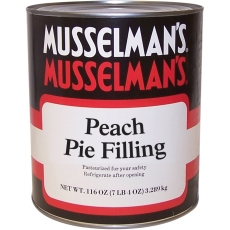 Well, this is no small feat! I've been trying for years to create the above-mentioned peach pie, with no luck. I've even resorted to buying canned peach fillings (yuck) and blending my peaches with flavored gelatin to create a single-crust mousse-type pie (it's OK, but not the same thing as a fresh peach pie).
Well, this is no small feat! I've been trying for years to create the above-mentioned peach pie, with no luck. I've even resorted to buying canned peach fillings (yuck) and blending my peaches with flavored gelatin to create a single-crust mousse-type pie (it's OK, but not the same thing as a fresh peach pie).
So when I found this Cook's Illustrated article, I was elated. Now for your baking pleasure, here are America's Test Kitchen experts' (the folks that create the Cook's Illustrated magazine) 3 easy steps to a perfect peach pie—one that isn't soupy and tastes just peachy!
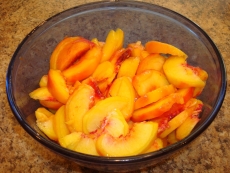 First some crucial basic information though: Most fresh fruit pie filling recipes tell you to toss fruit in sugar and spices. But the problem for peaches is that sugar has an osmotic action on the slices. Sugar easily attracts water to itself—making it superbly capable of pulling juice out of the peaches' cells.
First some crucial basic information though: Most fresh fruit pie filling recipes tell you to toss fruit in sugar and spices. But the problem for peaches is that sugar has an osmotic action on the slices. Sugar easily attracts water to itself—making it superbly capable of pulling juice out of the peaches' cells.
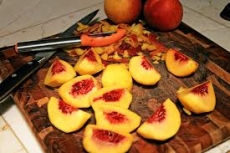 The Test Kitchen cooks discovered that to gain control over the consistency of the filling, and since osmosis occurs on the surface, the best thing to do was to make the peach slices relatively large to minimize total surface area. (Who knew?) So instead of slicing the peaches thin, they sliced them into quarters and then cut each of these into thick—but still bite—size-1-inch chunks.
The Test Kitchen cooks discovered that to gain control over the consistency of the filling, and since osmosis occurs on the surface, the best thing to do was to make the peach slices relatively large to minimize total surface area. (Who knew?) So instead of slicing the peaches thin, they sliced them into quarters and then cut each of these into thick—but still bite—size-1-inch chunks.
The next thing the Test Kitchen pros did was to let the sugared peaches macerate for a bit and then drain off the juice before tossing the fruit into the pie, adding back only enough juice to moisten—not flood—the filling.
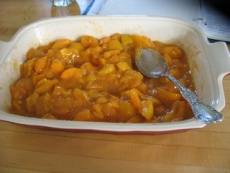 Whoa right here...what the heck does it mean to "let the sugared peaches macerate?" I needed to look this term up: To macerate something is to soften it by soaking it in liquid. You usually hear the word used in recipes that include fresh or dried fruit. Macerating fresh fruit releases some of its juices, creating a sweet syrup.
Whoa right here...what the heck does it mean to "let the sugared peaches macerate?" I needed to look this term up: To macerate something is to soften it by soaking it in liquid. You usually hear the word used in recipes that include fresh or dried fruit. Macerating fresh fruit releases some of its juices, creating a sweet syrup.
The cooks did this because it allowed them to control how much liquid the peaches contributed. They tossed 3 pounds of peaches with 1/2 cup sugar, 1 tablespoon of lemon juice, and a pinch of salt. When they drained the peaches 30 minutes later, they yielded more than 1/2 cup of juice, which was the right amount to moisten the filling.
OK, now we're ready for those 3 easy steps to creating the perfect peach pie filling:
- Limit juice. Macerate large chunks of peaches and reserving the resulting juice allows you to add only as much liquid as the filling can handle—no more.
- Add pectin and cornstarch. A combination of pectin and cornstarch keeps the filling smooth, clear, and moist without being soupy.
- Make a sticky mash. A bit of mashed-up peaches added to the filling acts like glue, preventing any peach chunks from falling out of the slice of pie when served.
Now how about combining this tutoring with the perfect recipe for the perfect filling? Here's what the Test Kitchen cooks created and the feedback has been 100% positive all around! Armed with this information and recipe I'm sure I'll never need to turn to canned filling or a mousse-type pie again—when it's fresh peach pie that we want, it'll be fresh peach pie that we get!
Cook's Country Fresh Peach Pie Filling
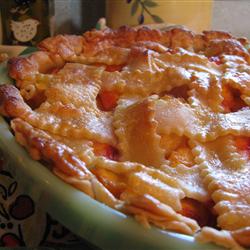
Finally the perfect peach pie filling—not soupy or pasty tasting. Be prepared for demands for more!
Serving size: 5
Calories per serving: 216
3 pounds fresh peaches peeled, quartered, pitted; each quarter cut into thirds
1/2 cup plus 3 tablespoons sugar divided
1 teaspoon grated lemon zest
1 tablespoon fresh lemon juice
1/8 teaspoon salt
2 tablespoons low- or no-sugar-needed powdered pectin
1/4 teaspoon ground cinnamon
pinch ground nutmeg
1 pie pastry, recipe , (lattice top)
1 tablespoon cornstarch
Directions:
Prepare dough for pie pan (work on oiled parchment paper). TIP: Cut lattice strips with pizza wheel and freeze until firm, about 30 minutes. This makes for easing weaving.
Adjust oven rack to lowest position, place rimmed baking sheet on rack, and preheat oven to 425°.
Meanwhile, transfer 1 cup peach mixture to small bowl and mash with fork until coarse paste forms. Drain remaining peach mixture through colander set in a large bowl. Transfer peach juice to liquid measuring cup (you should have about 1/2 cup liquid; if liquid measures more than 1/2 cup, discard remainder). Return peach pieces to bowl and toss with cornstarch. Transfer peach juice to 12-inch skillet, add pectin mixture, and whisk until combined. Cook over medium heat, stirring occasionally, until slightly thickened and pectin is dissolved (liquid should become less cloudy), 3 to 5 minutes. Remove skillet from heat, add peach pieces and peach paste, and toss to combine.
Transfer peach mixture to dough-lined pie-plate. Remove dough strips from freezer; if too stiff to be workable, let stand at room temperature until malleable and softened slightly, but still very cold. Weave and crimp edges.
Place pie on preheated sheet and bake until crust is set and begins to brown, about 25 minutes. Rotate pie and reduce oven temperature to 375°; continue to bake until crust is deep golden brown and filling is bubbly at center, 25 to 30 minutes longer.
Recipe formatted with the Cook'n Recipe Software from DVO Enterprises.
- www.sunset.com
- www.webstaurantstore.com
- www.teresawarner.com
- www.zentmrs.blogspot.com
- www.cookwithwhatyouhave.com
- www.allrecipes.com

Alice Osborne
Weekly Newsletter Contributer since 2006


